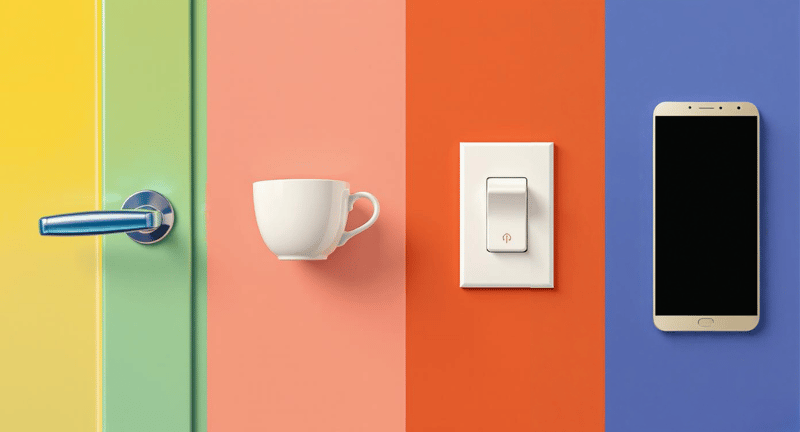Design is everywhere – UX/UI in the real world

- UX, the heart of everyday design
- Design is all around us, we just don’t notice it
- UX vs UI in everyday life
- Why good UX/UI matters, even if you’re not a designer
- How to spot what’s not working
- Coming up: “Thinking like a user – The psychology behind UX”
- Now, do everyday things look a little more… designed?
Have you ever stood in front of a sleek, modern faucet and hesitated, unsure how to make the water flow? Maybe you waved your hand underneath, searched for a hidden button, or turned a handle that moved in three different directions – only to end up splashing water everywhere, or simply giving up.
It’s a small moment, but it reveals a big truth: when design tries too hard to be clever, simple tasks can become needlessly confusing.
When most people think of design, they picture colors, logos, or visuals. But design is much more than that – it’s how something works, how it guides you, and how it makes you feel.
UX, the heart of everyday design
Don Norman, the cognitive scientist who coined the term “User Experience” (UX) in the 1990s, explains that UX includes all aspects of a person’s experience with a product or service by not just how it looks, but how it works and how it fits into your life.
Good design, Norman says, is so easy to use that you don’t even notice it. When things work naturally and smoothly, they create a better experience, making everyday life simpler and more enjoyable.
Design is all around us, we just don’t notice it
We interact with design hundreds of times a day, from the bathroom sink to the apps on our phones. Usually, when everything works seamlessly, we don’t give it a second thought –
-
You walk into a room and flip a light switch without fumbling
-
You see a sign and immediately know where to go
-
You pour coffee without questioning how the kettle works
-
You tap a button on a website and it responds instantly
-
You fill a form, get a confirmation, and move on
That’s design doing its job – quietly, effectively, invisibly.
But when that flow is interrupted – by a faucet you can’t figure out, a light switch you can’t find, a website form that gives no feedback, or a mobile app that hides the main menu – you feel the sting of bad design. It’s not you. It’s the design.
And once you start noticing it, you’ll see that the real power of design isn’t just in how things look, but in how things work – online, offline, and everything in between.
UX vs UI in everyday life
We’ve already seen what UX is: it’s how things work, how they guide you, and how they make you feel.
UI, or User Interface, is how it looks — the buttons, labels, screens, icons. Basically, anything you interact with visually or physically.
Picture this:
You walk into a coffee shop.
-
The door opens smoothly
-
The menu is clear, no puzzles
-
You order in 30 seconds. Your name’s spelled right. You get your drink fast
-
The Wi-Fi connects without drama. The music isn’t too loud. The chairs don’t wobble
That whole vibe? That’s UX. A seamless, thoughtful experience.
Now, zoom in:
-
The design of the menu board – fonts, layout, icons.
-
The touchscreen you used to place your order.
-
The style of the buttons on that screen, the color of the “Pay” button and the size of the “Back” arrow.
-
Even the coffee cup – is it easy to hold? Is the label readable?
That’s UI. It’s the tangible visual elements that guide your experience.
You feel UX. You see and use the UI.
The best design brings both together. One without the other? You get either confusing clutter or beautiful frustration.
Why good UX/UI matters, even if you’re not a designer
You might not call yourself a designer. But if you’ve ever written a how-to guide, mapped out a process, or arranged anything that someone else has to use, you’ve already been designing, whether you realized it or not.
Design is the silent setup behind every interaction.
-
Think about the form no one wants to fill out because it’s confusing and clunky
-
Or the office signage that somehow leads everyone to the wrong place
-
Or that “easy” process that ends up needing 10 back-and-forth emails just to get done
That’s all bad design. And it quietly chips away at something valuable: your time, your trust, your credibility.
The worst part? Most people won’t bother telling you what’s not working. They’ll just avoid it. Or worse, they’ll avoid you.
But here’s the good news: fixing it doesn’t require fancy software or design degrees.What it does take is some clarity, empathy, and the will to make things better.
How to spot what’s not working
Start by asking yourself:
-
Is this easy for someone else to use, or does it make them work?
-
Would they know what to do even if I wasn’t there to explain it?
-
If I were in their shoes, would I find this clear, simple, and respectful of my time?
If not, tweak it. Clean it up. Make it obvious, because that’s design too. Good design isn’t about being clever or making things look pretty; it’s about being helpful, human, and clear. It’s communication without confusion, and the best part? Anyone can do it.
Coming up: “Thinking like a user – The psychology behind UX”
Now that we’ve seen how design shows up everywhere, what happens when we start thinking from the user’s perspective? What shapes their decisions, frustrations, or trust in a system?
In the next post, we’ll explore how small shifts in psychology can completely change the user experience and what that means for anyone building anything for others. Better design starts with better thinking.
Now, do everyday things look a little more… designed?
If this post got you noticing the design around you — great. That’s the first step.
At ShikhaShikz Marketing, we focus on the subtle details that others miss, the ones that turn visitors into customers. Because when businesses prioritize UI/UX, they’re silently telling prospects, “We care.” And that builds trust, keeps them engaged, and fuels demand generation.
So, ready to turn your website into a story worth staying for? Let’s design experiences that don’t just attract – but convert. We are keen to hear your story.
Related content worth reading

CMS Trials: A Field Journal from My Log
Discover why choosing the right Content Management System is crucial for effective website management and growth.

Multi-channel marketing guide to end campaign chaos
5 Multi-channel mistakes killing growth. Avoid messy messaging, poor tracking and more – turn chaos into results.
